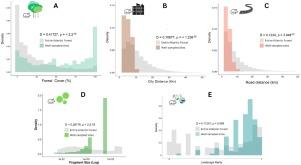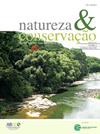Spatial bias in sampling small rodents in the Atlantic Forest: A landscape and accessibility perspective
IF 3.5
2区 环境科学与生态学
Q1 BIODIVERSITY CONSERVATION
引用次数: 0
Abstract
Understanding the effects of habitat loss and fragmentation on species spatial distribution is challenging, mainly because knowledge of species occurrences is biased. Survey efforts are unevenly distributed causing spatial sampling biases that are normally neglected. Assessing sampling bias is particularly urgent for threatened ecoregions, such as the Atlantic Forest, a global biodiversity hotspot. Here, we assess spatial sampling biases of small rodents in the Atlantic Forest, using an integrative approach with accessibility and landscape metrics. We built a robust dataset of 11,495 primary records of the Atlantic Forest’s small rodent species, based on information from digitally accessible repositories. We expect that well-sampled sites are spatially aggregated and nearer roads, urban centers, on landscapes with larger forest fragments, and with higher percentage of forest cover. We also expect gaps of small rodents sampling in rare landscape conditions. Our results indicated that only less than 1% of the Atlantic Forest (at 1 km2 cell-size resolution) are well sampled. Following our expectations, the well-sampled sites were spatially aggregated biased toward roads, urban centers, larger forest fragments, and landscapes with higher percentage of forest cover. We also found a survey gap on common landscape conditions. Our findings suggest that the spatial distribution of small rodents at landscape level (1 km2) remains unknown across most of the Atlantic Forest spatial extension. Our findings also point to new priority sites for small mammals sampling on common landscape conditions, in smaller fragments and on remote areas improving spatial distribution knowledge and contributing to conservation policies at landscape level.

大西洋森林小型啮齿动物采样的空间偏差:景观和可达性视角
了解栖息地丧失和破碎化对物种空间分布的影响具有挑战性,这主要是因为对物种出现情况的了解存在偏差。调查工作分布不均,造成了通常被忽视的空间取样偏差。对于大西洋森林等受到威胁的生态区来说,评估取样偏差尤为迫切,因为大西洋森林是全球生物多样性的热点地区。在本文中,我们使用一种综合方法,结合可达性和景观指标,对大西洋森林小型啮齿动物的空间取样偏差进行了评估。我们建立了一个包含 11,495 条大西洋森林小型啮齿动物原始记录的强大数据集,该数据集基于可访问的数字资料库中的信息。我们预计,取样良好的地点在空间上比较集中,靠近公路、城市中心、森林面积较大、森林覆盖率较高。我们还预计,在罕见的地貌条件下,小型啮齿类动物的采样会出现缺口。我们的结果表明,大西洋森林中只有不到 1%的区域(单元大小分辨率为 1 平方公里)采样良好。按照我们的预期,取样良好的地点在空间上偏向于道路、城市中心、较大的森林片段以及森林覆盖率较高的地貌。我们还发现在常见景观条件方面存在调查空白。我们的研究结果表明,在大西洋森林空间延伸的大部分地区,景观水平(1 平方公里)上小型啮齿动物的空间分布仍然未知。我们的研究结果还为小型哺乳动物在常见景观条件、较小片区和偏远地区的取样工作指出了新的优先地点,从而提高了空间分布知识,有助于在景观层面制定保护政策。
本文章由计算机程序翻译,如有差异,请以英文原文为准。
求助全文
约1分钟内获得全文
求助全文
来源期刊

Perspectives in Ecology and Conservation
Environmental Science-Nature and Landscape Conservation
CiteScore
7.80
自引率
4.30%
发文量
46
审稿时长
59 days
期刊介绍:
Perspectives in Ecology and Conservation (PECON) is a scientific journal devoted to improving theoretical and conceptual aspects of conservation science. It has the main purpose of communicating new research and advances to different actors of society, including researchers, conservationists, practitioners, and policymakers. Perspectives in Ecology and Conservation publishes original papers on biodiversity conservation and restoration, on the main drivers affecting native ecosystems, and on nature’s benefits to people and human wellbeing. This scope includes studies on biodiversity patterns, the effects of habitat loss, fragmentation, biological invasion and climate change on biodiversity, conservation genetics, spatial conservation planning, ecosystem management, ecosystem services, sustainability and resilience of socio-ecological systems, conservation policy, among others.
 求助内容:
求助内容: 应助结果提醒方式:
应助结果提醒方式:


